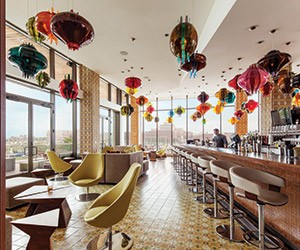Indianapolis is a vibrant destination with much to offer meeting groups, and now it is easier than ever to access the city’s various points of interest, thanks to the 7.5-mile, $63 million Indianapolis Cultural Trail (ICT), which was completed this summer.
“The Indianapolis Cultural Trail unites pedestrians with the city’s cultural districts,” says Leonard Hoops, president and CEO of Visit Indy. “Connectivity has been the calling card for Indy for a long time. We have more hotel rooms (4,700) connected to the conference center than any other city, and now people can connect easily with our arts and theater.”
Public art installations are scattered throughout the trail, including a unique experiential piece entitled Chatham Passage by artist Sean Derry. A floral aroma is released through a steel grate in the ground, complemented by LED light effects.
“People turn into a certain alleyway and wonder why it smells so good, when they’re really experiencing public art,” says Hoops, who describes it as a “scent vault.”
Care/Don’t Care is another piece that at first glance blends into the urban street scene. Resembling a typical Walk/Don’t Walk pedestrian street signal, the sign changes messages at random intervals, but can also be triggered by a pedestrian pressing a button below.
Attendees and business travelers can enjoy the trail and all its sites without hassle, as it crosses directly in front of the Indiana Convention Center and is convenient to Embassy Suites Indianapolis Downtown, Conrad Indianapolis, Hyatt Regency Indianapolis and other large convention properties.
Designed as an urban linear park, the trail weaves through six diverse areas and was constructed in segments over several years. Each portion offers its own set of venues and attractions for planners to consider. Following is a roundup of the neighborhoods.
White River State Park: Revitalized in the 1980s, this large urban state park centers on the Indiana Central Canal, encompassing 250 acres of urban green space where groups can rent a pedal boat and cruise down the 1.5-mile waterway, or enjoy a picnic for hundreds of attendees. Whether you’re looking to plan a concert, relax on the lawn or hold an event on one of the many green spaces, there is an assortment of facilities available. The park is also home to many of Indy’s biggest attractions, including the zoo (see sidebar, this page, to learn about the soon-to-open orangutan center), an IMAX theater, a minor-league baseball park and the Indiana State Museum. As many as 10,000 people can gather in Celebration Plaza and the adjoining 1,500-seat outdoor amphitheater, or groups can dine under the trellises of a waterfront pavilion.PageBreak
Wholesale District: This business district is home to big-name hotels and entertainment; Bankers Life Fieldhouse, where the Indiana Pacers play; Lucas Oil Stadium, which hosted the Super Bowl in 2012; and the Indiana Convention Center and surrounding lodging choices. The sports venues offer group tours and function space, and Wholesale District visitors pass under the seven-story glass-enclosed Indianapolis Artsgarden dome as they walk to and from the Circle Centre shopping mall. Hotels include the Conrad Indianapolis, Omni Severin, Canterbury Hotel and Crowne Plaza Indianapolis, which will complete a renovation of all 273 guest rooms and public areas in January. The properties offer 15,000, 17,000, 55,000 and 2,000 square feet of meeting space, respectively.
Indiana Avenue: In the 1920s and ’30s, Indiana Avenue was a hot spot for jazz music, and the tradition continues today. The Madame Walker Theatre Center, named after the first self-made female millionaire in America, hosts shows and events, such as the monthly Jazz on the Avenue. The Freetown Village living history museum showcases the neighborhood and state’s African American heritage though workshops, crafts and interpretive theater performances. The avenue also has a memorial library dedicated to Indianapolis native and iconic author Kurt Vonnegut.
Fountain Square: Bocce ball, delicious po boy sandwiches and craft beer are the draws at B’s Po Boy, and nearby Duckpin Bowling is one of only a handful of authentic duckpin-style bowling alleys in the country, using smaller balls that don’t have finger holes as well as pins that are shorter than those used in standard 10-pin bowling. After working up a thirst rolling strikes, attendees can stop by the New Day Meadery tasting room. Crafting mead and hard cider from local fruit and honey, the venue’s Apiary room can seat 30 and can be booked in conjunction with the general tasting room for larger groups.
Mass Avenue: Comprising five blocks lined with art galleries and theaters, Mass Avenue entertains visitors for hours, with quirky shopping, bookstores like Indy Reads Books that give back to the community to support local literacy, and Theater on the Square, which spotlights award-winning community theater productions.
Broad Ripple Village: Another Indianapolis-raised celebrity, David Letterman, called Broad Ripple home once upon a time. Located north of downtown, the district features a number of dining and nightlife spots. The Vogue nightclub originally opened in 1938 as a movie theater, but after becoming a music venue in 1970s has hosted performers including Johnny Cash, Willie Nelson, Rusted Root and the Red Hot Chili Peppers. Located in a bend of the White River inside a charming blue Victorian home and celebrated for its vegetarian and breakfast dishes, 3 Sisters Cafe is a must during any visit to Broad Ripple. The restaurant also offers catering packages.






